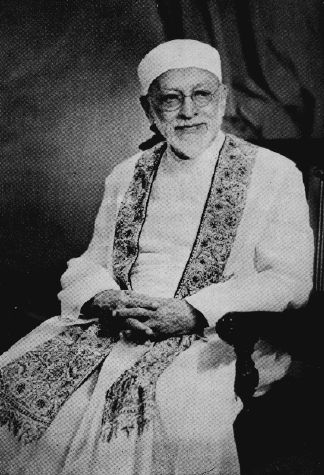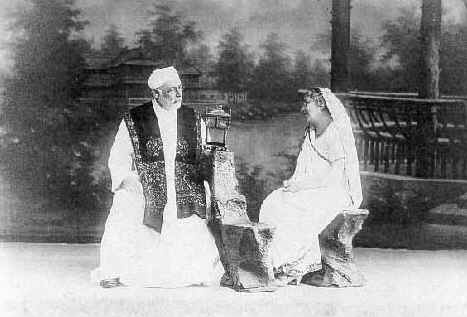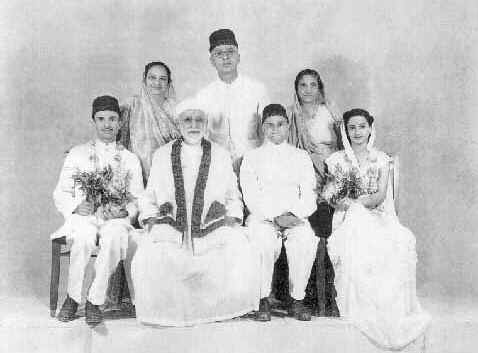
Dastur Dr. M. N. Dhalla
M.A, Ph.D. (Columbia), USA
By Roshan Rivetna,
Hinsdale, Illinois
As High Priest of the Parsis of Karachi, Pakistan for over 45 years Dastur Dhalla was a scholar and teacher of rare brilliance, who stood unruffled through many communal controversies. This article portrays the man behind the Dasturji, as his granddaughter Remembers ‘Bapa’.
 "Bapa was a person to whom birds, animals and children came on their own. It
was as if they felt and knew that he was someone special who would be a friend to
them," recalls Pouruchisti Bharucha about her grandfather. "I remember when our
compound was much bigger and we had all sorts of birds in a huge cage in the garden and
animals - dogs, a monkey, a goat, a cow, a horse and a very sweet little deer. After lunch
Bapa would come down and feed the animals and birds that would be waiting for him. It was
not their normal food, but things he had saved for them from his own lunch. He talked to
them as if they were his friends and they seemed to understand what he was saying. He
would then water his plants and talk to them too.
"Bapa was a person to whom birds, animals and children came on their own. It
was as if they felt and knew that he was someone special who would be a friend to
them," recalls Pouruchisti Bharucha about her grandfather. "I remember when our
compound was much bigger and we had all sorts of birds in a huge cage in the garden and
animals - dogs, a monkey, a goat, a cow, a horse and a very sweet little deer. After lunch
Bapa would come down and feed the animals and birds that would be waiting for him. It was
not their normal food, but things he had saved for them from his own lunch. He talked to
them as if they were his friends and they seemed to understand what he was saying. He
would then water his plants and talk to them too.
"When we went out with him in the ‘gari ’ (horse-carriage), he would point out a tree or a cloud or little kids playing or even a pretty woman - to him, everything had a touch of God and was to be admired."
‘Bapa’ was Dasturji Dr. Maneckji Nusserwanji Dhalla, M.A., Ph.D., whom the Parsis of Karachi (now in Pakistan) had appointed as their High Priest and which office he served, not only as a ceremonial dastur, but also a scholar and teacher, for over 45 years until his death in 1956. ‘Bapa’ was the public servant and citizen on whom the British goverment had bestowed the exalted title of "Shams-ul-Ulema" in 1935. Only three Parsis (Dastur Peshotan, Dastur Darab Sanjana and Ervad Jivanji Mody) had earned this prestigious title before him.
‘Bapa’ was the scholar of Avesta, Pahlavi, Persian, Gujarati and English literature, on whom Columbia University had bestowed the degree of Litt. D., on the occasion of its 175th anniversary, in 1929.
‘Bapa’ was the eminent theologian, who, alone, could convincingly satisfy the desire of the modem Parsi youth for enlightenment in matters spiritual. By dint of his profound intellectual powers, unmatched knowledge of the doctrine, and persuasive rhetoric, he was instrumental in creating a resurgence of religious awakening among the youth, who flocked by the hundreds to hear his brilliant lectures.
‘Bapa’ was the orator and speaker eagerly sought for speaking engagements all over India, UK, and the US; who spoke with flaming enthusiasm and animation, stirring up religious enthusiasm among his hearers. He taught that religion is a thing of the heart, not of the head. When he spoke, his countenance radiated light and his listeners felt that their souls had awakened to a new life!
‘Bapa’ was the genius that flowered in his nine major books and countless papers on Zarathushti religious literature, history and theology. But, as Pouruchisti remembers, most of all, "Bapa was a very kind and gentle soul." She adds: "I have never seen him angry with anyone. He enjoyed doing his own daily work, such as making his bed, dusting his books and washing his own teacup.
"He was so highly learned, but he was a simple soul when it came to matters of money. He would have to turn a coin over to read its worth. I remember once, he received Rs. 101 ‘ashodad’ (gift) for performing a child’s navjote, which in those times was a very large sum. He showed me the notes and said: ‘Pouruchishti, aaprey aatla badha paisa-nu shoo karshu? (What will we do with so much money?).’ I am sure my Dina Fui, who looked after Bapa’s money, was very pleased with this amount."
Early life
Dastur Dhalla was born in 1875 at Surat. His parents lived in a hovel in one of the poorest parts of the city, where his father and uncle practiced the priesthood. According to the custom of those times, Maneckji was married at the age of nine to a girl, Cooverbai, from a well-to-do priestly family of Navsari, who was barely 5 or 6 years old.
Pouruchisti tells a little story about the marriage. "Bapa and Motamama had their navjote performed in the morning and got married the same evening. After the wedding Motamama stayed with her family in Navsari. When Mama was nearly 18 years old, Bapa went to Navsari with his family to bring his bride home. As they arrived in Navsari, Bapa went out for a walk in the afternoon, to pass the time until the family went to the bride’s house that evening. He came upon a well where several young girls were drawing water. There he saw, and immediately fell in love with one of the girls. He went back home and told the story to his family - which he had chanced upon a girl at the well, whom he had fallen in love with at first sight.
"Of course, the family forced him to go to his in-laws that evening. And to his utter surprise and joy, the ‘dream girl’ he had fallen in love with at the well, turned out to be his own wife."
Maneckji was ordained a navar at the age of 12. At 19, in order to make a living, he took up a clerical job in Karachi, which he held for 8 years. But all through this period (1894 -1901), Maneckji did not forsake his overwhelming aim in life to become a scholar. He would get up at 4 am, and devote at least three hours every morning to reading and writing before proceeding to his office. After work he would stop by the library, and devote another three hours every day to his studies.
Through his painstaking studies, he had acquired enough knowledge about the Zarathushti religion, to publish a monthly pamphlet called Gulshan-e-Danesh at the age of 20. At 22, he published his first book (of 120 pages) on the religion reflecting his views during this highly orthodox, early period of his life.
During this time, Maneckji was also making his mark as an erudite and knowledgeable public speaker. On one such occasion, he so impressed an eminent, visiting theologian, Mr. K. R. Cama, [after whom the renowned K. R. Cama Oriental Institute of Mumbai is named] that the latter made a fervent appeal to the Parsis in Karachi to send Maneckji for a training course at the Athoman Madressa in Bombay. With Rs. 25 per month from the Karachi Parsi Anjuman and a matching amount from K. R. Cama himself, Maneckji came to study at the Madressa. Working hard day and night, with zeal and diligence, he completed the 5-year course in 3 years.
His teachers at the Madressa had instructed him in knowledge based on tradition. But "tradition", Dhalla averred "is stagnant, and knowledge is ever on the move. Besides, tradition is wedded to the time that is dead, and knowledge looks forward to the time to be born."
Further studies at Columbia
Dhalla was now filled with a longing to proceed abroad for further studies in Avesta-Pahlavi with scholars at Oxford, Berlin or Columbia University. With monthly pledges of Rs. 125 from the benevolent Tata Trust funds, Rs. 50 from the Karachi Anjuman, and additional amounts from K. R. Cama and Jivanji Mody, Dhalla left the shores of India in 1905, by sea, via Genoa, to study under Prof. A. V. W. Jackson at Columbia. His wife and (by now) four children stayed behind in India. At Columbia, Maneckji devoured the writings of the great thinkers, sages, writers and historians. He got up at 4 am and was the last pupil to leave the library hall at 11 pm every night. For him there was no delight to compare with intellectual delights; and moreover, he felt he was in debt to the entire Parsi community, and wanted to prove worthy of their trust. On his return from Columbia, Dr. Dhalla was a transformed man. His ideas, views and thinking had undergone a metamorphosis. His studies at the University gave him a historical perspective, logical reasoning, and critical acumen. He had sought the truth by coordinating and collating all the philosophies and sciences, which now gave a different color to the orthodox and staunch views on rituals, ceremonies, social customs and prayers, that he had held in the past.
Dr. Dhalla later learnt that our religious writings do not contain the teachings of our Prophet alone. They embody a conglomeration of the beliefs, rituals, superstitions, allegories, myths and mysticisms prevailing in the post-Prophet era. Our religious books incorporate both sacred teachings and secular ideas. With the passage of time, both were recognized as gospel truth, and were passed down to posterity as religion.
Dhalla concluded that Prophet Zarathushtra never gave ceremonies and rituals, the predominant position they hold in religion today. He affirmed that ceremonies as such were not the be-all and end-all of the Zarathushti religion. Heavenly bliss cannot be gained merely by the performance of death ceremonies. Only a righteous life, a virtuous life, a helpful life on this earth would open up the doors to Garothman Behesht.
High Priest
In 1909, at the age of 35 years, Dr. Dhalla was installed as the High Priest of Karachi. Blessed with a pleasant and dignified personality, Dastur Dhalla was a commanding figure in the most august assemblies. Dressed in the spotless, white cotton robes, cummerbund and turban of the Zarathushti priest, his shawl denoting the rank of a Dastur, he impressed every gathering as he acknowledged its respectful homage before taking his seat. When he rose to speak, he held his audience spellbound. Dastur Dhalla served the community in this office for over 45 years.
Books and writings
More than just a ceremonial priest, Dhalla was also a prolific author. Among his earliest works was ‘Niyaishes or Zoroastrian Litanies’, in 1909. In this valuable work, each Niyaishe is treated, passage by passage, in the transliteration of its five versions: Avesta, Pahlavi, Sanskrit, Persian and Gujarati, with an English translation by Dr. Dhalla.
His "Zoroastrian Theology" was launched at Columbia, in 1914 for which he made his second visit to the USA, with his wife, Cooverbai. World War I broke out during their stay in the USA, and their return voyage was fraught with danger from enemy action on the high seas. While in England on his way back, he performed Europe’s first navjote Ceremony. Zoroastrian Theology provides, in one book, a complete history of Zarathushti religious beliefs from pre-Gathic times to the present day.
In 1921, Dastur Dhalla and Cooverbai once again sailed to the USA to publish his book "Zoroastrian Civilization". Here he deals with abstract concepts of the religion in a manner meaningful to the lay person. He reviews, in the pages of this book, recourse of Zarathushti history, discusses the evolution of the religion from earliest times to the downfall of the last Zarathushti Empire in 651 AD, the development of Zarathushti society, and the evolution of the Zarathushti way of life.
In 1929, Dasturji and Cooverbai were invited by Columbia University to attend celebrations for its 175th anniversary. On this occasion, Dastur Dhalla was awarded an honorary Litt. D. Degree. He also took the opportunity to publish ‘Our Perfecting World - Zarathushtra’ s Way of Life.’ In this volume one sees flashes of transcendental beauty and devout fervor. His wisdom, knowledge based on vast reading and careful observation, and righteousness is reflected in its pages.
During his fifth and last visit to the USA, Dastur Dhalla published his classic "History of Zoroastrianism." A revised and much enlarged edition of Zoroastrian Theology, which had long been out of print. Here he surveys the millennia in six chronologica1 periods: pre-Gathic, Gathic, Avestan, Pahlavi, a Period of Decadence, and a Period of Revival.
In his autobiography "Ek Atma-katha", he displays that as a true Zarathushti, he ungrudgingly acceptetd the fact that in his life there was a mingling of joy and sorrow, peace and strife, happiness and suffering.
Family
 Within
four months of the publication of his autobiography, his beloved Cooverbai passed away,
and for Dasturji, life without her comforting presence seemed unbearable. "Bapa and
Motamama’s love was something so beautiful that it touched everyone around
them," writes Pouruchisti. "There was nothing they would not do for each other.
After Motamama died, Bapa was never a whole person. He missed his other half. Each time he
performed a navjote or wedding, he would take his garland and flowers, place it near his
beloved Cooverbai’s photo, and talk to her about the ceremony.
Within
four months of the publication of his autobiography, his beloved Cooverbai passed away,
and for Dasturji, life without her comforting presence seemed unbearable. "Bapa and
Motamama’s love was something so beautiful that it touched everyone around
them," writes Pouruchisti. "There was nothing they would not do for each other.
After Motamama died, Bapa was never a whole person. He missed his other half. Each time he
performed a navjote or wedding, he would take his garland and flowers, place it near his
beloved Cooverbai’s photo, and talk to her about the ceremony.
"If he had been a lesser person, he would have wished to die with her. But his faith in his God was very strong, and he knew that only God knew what was best." Dasturji passed away fourteen years later, at the age of 81, in 1956.
Of him was written l:
"He was a unique genius who passed through this troubled world like a brilliant comet, radiating light and brilliance everywhere he went, elevating the thoughts and inspiring the lives of people. He appealed to the loftiest principles within the hearts of man in general, and Zoroastrians in particular; not only by the enviable logic of his astute mind, but by the invincible purity of his noble soul."
This article was compiled by Roshan Rivetna from materials provided by Dastur Dhalla's grand-daughter, Pouruchisti Jamshed Bharucha of Karachi, and her daughter Vahishta Canteenwalla. Vahishta came to Canada in 1975, and lives with her husband Jambi and two daughters, Shauna, 17, and Zara, 20, in Montreal, Quebec. Coincidentally,Vahishta and Jambi were married on Dastur Dhalla’ s 100th year birth anniversay.
Grateful acknowledgement is also given to the authors of the following two papers, from which information has been freely taken:
Eruch Kaikhushru Pavri, "Life and Works of Shams-ul-Ulema Dastur Dr. Maneckjee N. Dhalla", Published by Dastur Dr. Dhalla Memorial Institute, Karachi, 1973.
Miss Khorshed C. Laskari, Dastur Dhalla Memorial Essay, "Life and Works of Shams-ul-Ulema Dastur Dr. Maneckji Nusserwanji Dhalla", 1973.
Roshan Rivetna is a software engineer working for Lucent Technologies. Roshan and her husband, Rohintan have been actively involved with the founding of the Zarathushti Association of Chicago (ZAC) and the Federation of Zarathushti Associations of North America (FEZANA). Roshan is the creator and editor-in-chief of the FEZANA Journal.
This page was last updated on Tuesday, August 01, 2000.